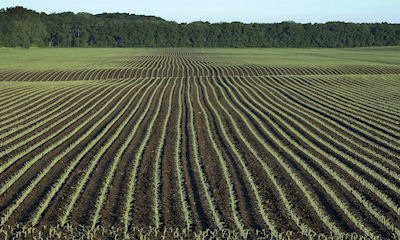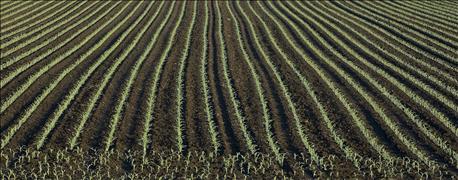May 10, 2016

Once corn has been planted and is ready to start emerging, it’s worthwhile for farmers to get ready to evaluate the uniformity of emergence. By taking time to evaluate your corn’s emergence success, “you as a grower will gain two very useful pieces of information,” says Shane Brockhoff, an AgriGold agronomist in western Iowa.
“First, evaluating corn emergence provides vital information on how successful the uniformity of emergence was,” he notes. “If the emergence was good, you know you had your planting system fine-tuned. If it was not adequate, the grower can begin working his or her way backwards to identify where and how the system could be improved for next year.”

CHECK CORN EMERGENCE: Fields with the most uniform emergence of a corn stand should be the fields that are targeted with extra production dollars. For example, if you want to determine where extra nitrogen should be side-dressed, or fields where foliar fertilizer or fungicides should be applied.
Fields that emerge more uniformly have higher yield potential
The second piece of information you gain is that within a couple weeks after planting, you have a really good idea which fields have the maximum potential and you can reallocate resources accordingly, says Brockhoff. “Fields that emerge within the 24 to 48 hour window have a higher percent yield potential than a field that took 48 to 96-plus hours to emerge. The tighter the emergence window the more uniform the plants and ultimately the more uniform the ears will be.”
If a grower is trying to determine if extra nitrogen needs to be applied as a sidedress, or if fungicides will be profitable or if the grower would like to try a foliar fertilizer product to maximize corn production, the grower automatically knows where to apply it. The fields with the most uniform emergence of the corn plants should be the fields that are targeted with extra production dollars.
Best way to measure the emergence timing of a field of corn
How do you accurately measure the emergence timing of a corn field? The most accurate method is the flag test, says Brockhoff.

The flag test was designed and refined by the National Corn Growers Contest Winner Randy Dowdy. He is a strong believer in the importance of uniform emergence of the corn plants and he wanted an accurate and reliable method to quantify his emergence. As described by agronomist Brockhoff, here is how Randy Dowdy performs the flag test:
1. At approximately when 85 GDU’s (growing degree units) have accumulated after planting, start checking for any signs of seedling emergence. A light movement of soil may be necessary to identify those seedlings that are just below the soil surface, waiting to pop through.
2. Mark off 1/1,000th of an acre, as this is the area you will quantify the emergence for the entire field. Ensure the area is a representation of the majority of the field, either by soil type, topography or planting conditions.
3. Once the first seedling corn plant can be seen (while you are on your hands and knees) put a colored flag next to all the plants that are spiked through.
4. Come back 12 hours later and place a different colored flag next to all the plants that have spiked since the last check.
5. Check every 12 hours using a different colored flag each time, until all the plants within the 1/1,000th of acre are emerged.
6. Make sure you record the order of flag colors and at what hour they were used.

The fields with the least amount of colors are the fields with the best uniform start and should carry a high percentage of yield potential for that field, says Brockhoff.
To verify if emergence does in fact matter on yield, he suggests you take time to go to the field before harvest and collect all the ears from each colored flag into a bucket. Then weigh the bucket and you’ll learn which bucket has the most weight per ear. “The flag test and resulting yield check is a great learning tool to demonstrate how emergence can positively or negatively affect corn yields,” says Brockhoff.
To view other related agronomic information, visit www.agrigold.com.
You May Also Like




